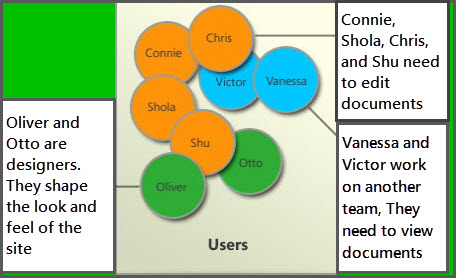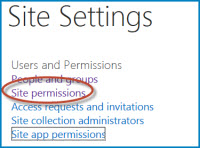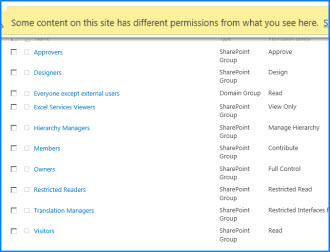Understanding SharePoint groups
A SharePoint group is a collection of users who all have the same set of permissions, or permission level. SharePoint groups can simplify the task of assigning and managing site access. Rather than track site or content access one person at a time, you can use groups to conveniently assign the same permission level to many people at once.
Assigning permission levels to SharePoint groups instead of individuals lets you:
-
Streamline site maintenance for yourself and successive site owners.
-
Ensure that people performing similar tasks have the same level of access.
-
Ensure that people have only the access they need, not more.
In this article
What are SharePoint groups?
A SharePoint group is a collection of SharePoint users. Typically, the people in a SharePoint group all do similar kinds of tasks on a site and need the same permission level. You can organize users into any number of groups, depending on the size and complexity of your organization or website. Typically, a SharePoint admin creates and manages the SharePoint groups at the site collection level.
Sorting into groups helps you easily combine people who use the site in similar ways. Some people only need to review content on the site, others might need to edit content, and others might need to add or edit content or other elements of the site itself. The following diagram that follows shows different groups of users and the kind of access they have to have.

Depending on the complexity of the business requirements, many organizations create customized strategies for managing access to resources. For example, you might have a special sub site where sensitive data is stored, and design a unique solution for keeping the data secure on the sub site.
For more information about permission levels, see Default permission levels.
Default SharePoint groups
For convenience, SharePoint pre-defines certain group, together with their associated permission levels. These are known as the default SharePoint groups and the default permission levels. When you create a site, SharePoint chooses some of the default groups to assign to the site, based on the template that you choose (Team Site, Publishing Site, and so on) to create the site.
The following table shows the most common default SharePoint groups, and their associated permission levels.
| Group name | Permission level |
| Visitors | Read |
| Members | Contribute or Edit, depending on the site template |
| Owners | Full Control |
| Approvers | Approve |
| Designers | Design |
| Hierarchy Managers | Manage |
| Restricted Readers | Restricted Read |
| Translation Managers | Restricted interfaces for translation |
Find the SharePoint groups on your site
You can discover the SharePoint groups that are set up on your site. To find the names of the groups, follow these steps:
-
Open the home page of the site
-
Next to the title bar, click the Settings
 icon
icon -
On the Site Settings page, locate the Users and Permissions group, and then select Site Permissions.

The Site Permissions page lists the SharePoint groups on the site and the permission level for each group.. SharePoint displays a message at the top of the list of groups that lets you know if unique permissions have been set up for any content.

No comments:
Post a Comment